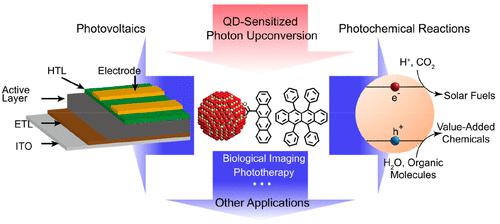当前位置:
X-MOL 学术
›
Acc. Mater. Res.
›
论文详情
Our official English website, www.x-mol.net, welcomes your feedback! (Note: you will need to create a separate account there.)
Quantum Dot-Sensitized Triplet–Triplet Annihilation Photon Upconversion for Solar Energy Conversion and beyond
Accounts of Materials Research ( IF 14.6 ) Pub Date : 2024-02-07 , DOI: 10.1021/accountsmr.3c00186 Zhiyuan Huang 1, 2 , Chen-Ho Tung 1, 2 , Li-Zhu Wu 1, 2
Accounts of Materials Research ( IF 14.6 ) Pub Date : 2024-02-07 , DOI: 10.1021/accountsmr.3c00186 Zhiyuan Huang 1, 2 , Chen-Ho Tung 1, 2 , Li-Zhu Wu 1, 2
Affiliation

|
The Nobel Prize in Chemistry 2023 was awarded to Moungi G. Bawendi, Louis E. Brus, and Aleksey Ekimov for the discovery and synthesis of quantum dots (QDs). Since the discovery of QDs in 1980s, endeavors have been put to improve synthetic strategies of QDs with controllable sizes, crystal structures, and surfaces. With the development of about half a century, QDs have been used in multiple optoelectronic applications, which are based on the conversion between one photon and one exciton. In this case, photons with energies lower than the bandgap cannot be absorbed by semiconductors. For example, solar cells or photocatalysts are transparent to sub-bandgap near-infrared (NIR) light in the solar spectrum, rendering a transmission loss.
中文翻译:

用于太阳能转换及其他用途的量子点敏化三重态-三重态湮没光子上转换
2023 年诺贝尔化学奖授予 Moungi G. Bawendi、Louis E. Brus 和 Aleksey Ekimov,以表彰他们发现和合成量子点 (QD)。自20世纪80年代发现量子点以来,人们一直在努力改进具有可控尺寸、晶体结构和表面的量子点的合成策略。经过大约半个世纪的发展,量子点已被用于多种光电应用,这些应用基于一个光子和一个激子之间的转换。在这种情况下,能量低于带隙的光子不能被半导体吸收。例如,太阳能电池或光催化剂对于太阳光谱中的亚带隙近红外(NIR)光是透明的,从而产生传输损耗。
更新日期:2024-02-07
中文翻译:

用于太阳能转换及其他用途的量子点敏化三重态-三重态湮没光子上转换
2023 年诺贝尔化学奖授予 Moungi G. Bawendi、Louis E. Brus 和 Aleksey Ekimov,以表彰他们发现和合成量子点 (QD)。自20世纪80年代发现量子点以来,人们一直在努力改进具有可控尺寸、晶体结构和表面的量子点的合成策略。经过大约半个世纪的发展,量子点已被用于多种光电应用,这些应用基于一个光子和一个激子之间的转换。在这种情况下,能量低于带隙的光子不能被半导体吸收。例如,太阳能电池或光催化剂对于太阳光谱中的亚带隙近红外(NIR)光是透明的,从而产生传输损耗。



























 京公网安备 11010802027423号
京公网安备 11010802027423号